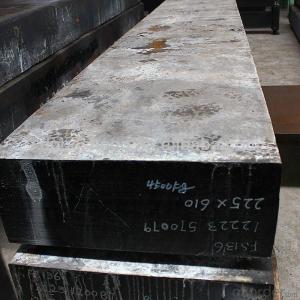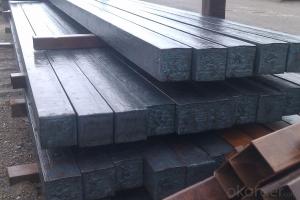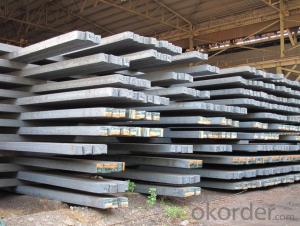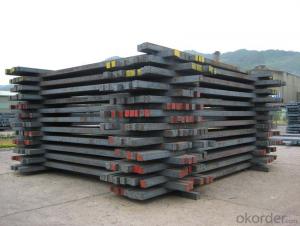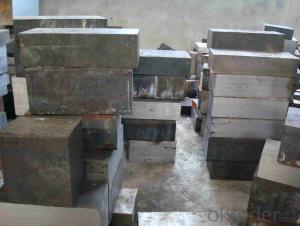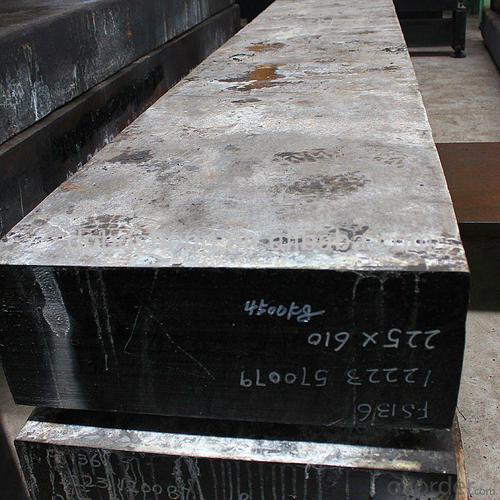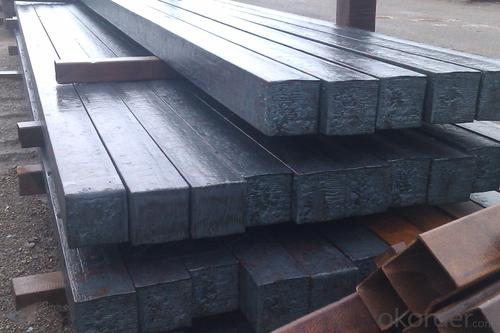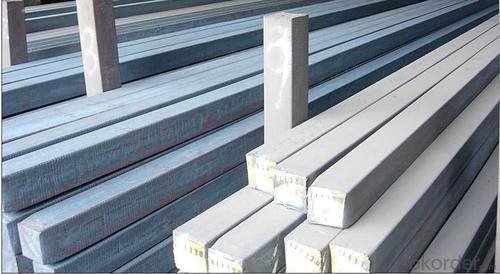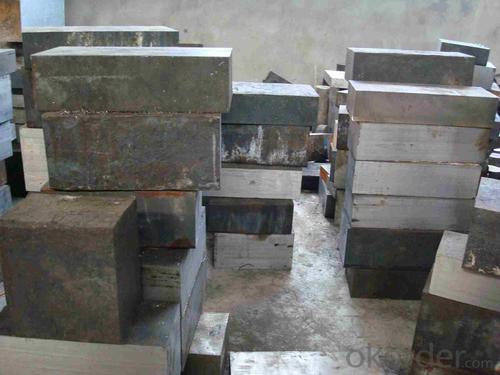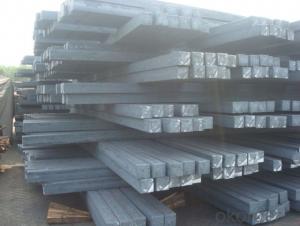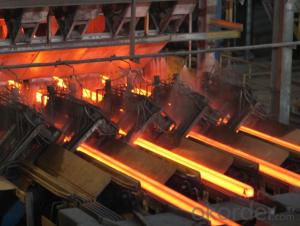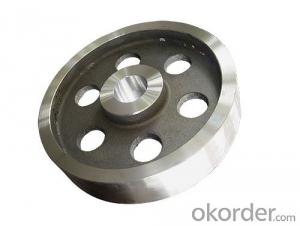Hot Rolled Square Steel Billet 3SP Standard 115mm
- Loading Port:
- Shanghai
- Payment Terms:
- TT OR LC
- Min Order Qty:
- 2000 m.t.
- Supply Capability:
- 10000 m.t./month
OKorder Service Pledge
OKorder Financial Service
You Might Also Like
Structure of Hot Rolled Square Steel Billet 3SP Standard 115mm
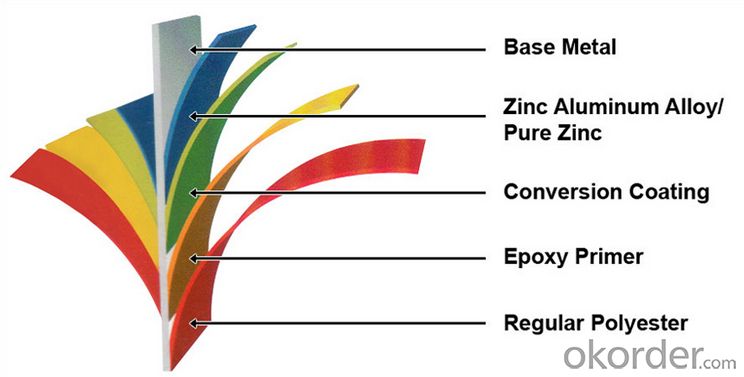
Description of Hot Rolled Square Steel Billet 3SP Standard 115mm
PPGI is made by cold rolled steel sheet and galvanized steel sheets as baseplate, through the surface pretreatment (degreasing, cleaning, chemical conversion processing), coated by the method of continuous coatings (roller coating method),
and after roasting and cooling. Zinc coating: Z60, Z80, Z100, Z120, Z180, Z275, G30, G60, G90
Alu-zinc coating: AZ60, AZ80, AZ100, AZ120, AZ180, G30, G60, G90

Main Feature of Hot Rolled Square Steel Billet 3SP Standard 115mm
1) Excellent corrosion resistance: The zinc layer provides a good protection of Pre-painted Galvanizeed Steel Sheet.
2) High heat resistance: The reflective surface of the material aids in efficiently reflecting the sunlight away and in turn reducing the amount of heat transmitted. The thermal reflectivity converts into energy savings.
3) Aesthetics: Pre-Painted Galvanized steel sheet is available in plethora of patterns and multiple sizes as per the requirements that given by our customers.
4) Versatility: can be used in the various areas.Standard seaworthy export packing: 3 layers of packing, inside is kraft paper, water plastic film is in the middle and outside GI steel sheet to be covered by steel strips with lock, with inner coil sleeve.
Applications of Hot Rolled Square Steel Billet 3SP Standard 115mm
1) Automotive bodies: filters, fuel tanks, etc.
2) Construction materials: roofings, welding pipes,
3) Electric and electronic appliances: computer cans, etc.
4) Steel cans: containers, etc.
5) Steel furniture: washing machines, refrigerators, microwaves, etc.
6) Drums
7) Office equipment: printer, recorders, etc.
8) Motors and transformers
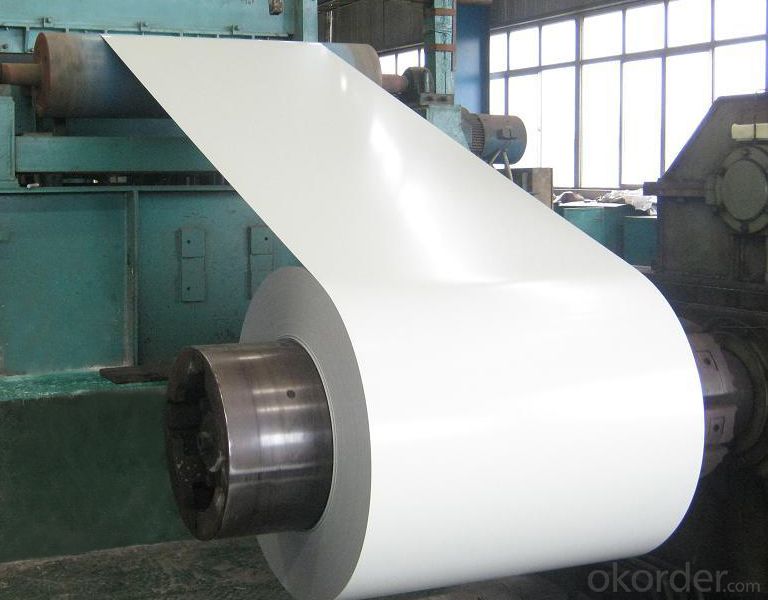
Specifications of Hot Rolled Square Steel Billet 3SP Standard 115mm
| Classified symbol | Yield Point Minimum N/mm2 | Tensile Strength Minimum | Elongation Minimum % | Application | ||||
| N/mm2 | Nominal Thickness mm (t) | |||||||
| JIS | Yogic | 0.25-0.4 | 0.4-0.6 | 0.6-1.0 | 1.0-1.6 | |||
| G3312 | specification | |||||||
| CGCC | CGCC | -205 | -270 | -20 | -21 | -24 | -24 | Commercial |
| CGCD | CGCD | --- | 270 | --- | 27 | 31 | 32 | Drawing |
| --- | CG340 | 245 | 340 | 20 | 20 | 20 | 20 | Structural |
| CGC400 | CG400 | 295 | 400 | 16 | 17 | 18 | 18 | Structural |
| CGC440 | CG440 | 335 | 440 | 14 | 15 | 16 | 18 | Structural |
| CGC490 | CG490 | 365 | 490 | 12 | 13 | 14 | 16 | Structural |
| CGC570 | CG570 | 560 | 570 | --- | --- | --- | --- | Structural |
| ASTM Designation | Yield Point Minimum | Tensile Strength Minimum | Elongation Minimum % | Application | Q/BQB 445-2004(China standard) | ASM A653/A653M | JISG 3312 | |
| ksi(MPa) | ksi(MPa) | TDC51D+Z | (CS TYPE A+Z) | CGCC | ||||
| A653(M)-99 CS TYPE A,B,C | --- | --- | --- | Commercial | TDC52D+Z | CGCD | ||
| A653(M)-99 FS | --- | --- | --- | Lock Forming | TS250GD+Z | (G250+Z) | - | |
| A653(M)-99 DS | --- | --- | --- | Drawing | TS300GS+Z | (G300+Z) | CGC 400 | |
| A653(M)-99 SS Grade33(230) | 33(230) | 45(310) | 20 | Structural | TS350GD+Z | (G350+Z) | CGC490 | |
| A653(M)-99 SS Grade37(255) | 37(255) | 52(360) | 18 | Structural | TS550GD+Z | (G550+Z) | CGC570 | |
| A653(M)-99 SS Grade40(275) | 40(275) | 55(380) | 16 | Structural | ||||
| A653(M)-99 SS Grade50(345) | 50(345) | 65(450) | 12 | Structural | ||||
| A653(M)-99 SS Grade80(550) | 80(550) | 82(570) | --- | Structural | ||||
FAQ of Hot Rolled Square Steel Billet 3SP Standard 115mm
We have organized several common questions for our clients,may help you sincerely:
1. How Can I Visit There?
Our company is located in Tianjin City, China, near Beijing. You can fly to Tianjin Airport Directly. All our clients, from home or aboard, are warmly welcome to visit us!
2. How Can I Get Some Sample?
We are honored to offer you sample.
3. Why choose CNBM?
1, ISO, BV, CE, SGS approved.
2, Competitive price and quality.
3, Efficient service team online for 24 hours.
4, Smooth production ability(50000tons/month) .
5, quick delivery and standard exporting package.
6, Flexible payment with T/T, L/C, Paypal, Kunlun bank, etc .
- Q: How are steel billets manipulated during the manufacturing process?
- Steel billets are manipulated in various ways during the manufacturing process to transform them into usable steel products. The manipulation techniques include heating, rolling, forging, and cutting. Firstly, the steel billets are heated in a furnace to a specific temperature, known as a rolling temperature. This heating process is crucial as it improves the billet's malleability and reduces its brittleness, making it easier to manipulate. Once heated, the billets are passed through a series of rolling mills. These mills apply pressure to the billets, which elongates and shapes them into the desired form. Rolling can be done using hot or cold methods, depending on the end product requirements. Hot rolling is typically used for large-scale production, while cold rolling is more commonly employed for precision applications. Another method of manipulating steel billets is forging. Forging involves applying compressive forces to the billets using hammers or presses. This process enhances the billet's strength, improves its grain structure, and refines its mechanical properties. Forged steel billets are often used in applications where high strength and resistance to impact and fatigue are required, such as in the automotive and aerospace industries. Cutting is also an essential manipulation technique during the manufacturing process. Steel billets are cut into desired lengths using saws or shears. This step ensures that the billets are converted into manageable sizes suitable for further processing or to meet specific customer requirements. In conclusion, steel billets undergo several manipulation techniques during the manufacturing process. These include heating, rolling, forging, and cutting. Each method contributes to transforming the raw billets into the desired shape and properties, ensuring they are suitable for various applications in industries such as construction, manufacturing, and transportation.
- Q: Can steel billets be used in the production of marine equipment?
- Yes, steel billets can be used in the production of marine equipment. Steel is known for its strength, durability, and corrosion resistance, making it a suitable material for marine applications. Steel billets, which are semi-finished products in the steel manufacturing process, can be further processed and transformed into various marine equipment components such as ship hulls, propeller shafts, rudders, and offshore structures. The high strength-to-weight ratio of steel makes it ideal for handling the demanding conditions encountered in marine environments, including exposure to saltwater, extreme temperatures, and mechanical stresses. Additionally, steel can be easily fabricated, welded, and machined, allowing for the customization and production of complex marine equipment designs. Overall, steel billets are a valuable raw material in the production of marine equipment due to their strength, durability, and suitability for marine applications.
- Q: What are the safety precautions to be taken while handling steel billets?
- When handling steel billets, there are several safety precautions that should be followed to ensure the well-being of individuals as well as the integrity of the material. Some key safety precautions include: 1. Personal Protective Equipment (PPE): It is essential to wear appropriate PPE such as gloves, safety glasses, and steel-toed boots to protect against potential injuries. Steel billets are heavy and can cause severe harm if dropped or mishandled. 2. Proper Lifting Techniques: When lifting steel billets, it is crucial to use proper lifting techniques, such as bending at the knees and keeping the back straight. This helps prevent strains, sprains, and other musculoskeletal injuries. 3. Adequate Training: Workers should receive proper training on how to handle steel billets safely. This includes understanding the weight and dimensions of the billets, knowing how to move them safely, and being aware of potential hazards. 4. Secure Storage and Transportation: Steel billets should be stored and transported in a secure manner to prevent accidents. They should be properly stacked, secured, and not overloaded to avoid falling or shifting during handling. 5. Clear Communication: In a work environment where multiple individuals are involved in handling steel billets, clear communication is essential. This includes using appropriate signals and verbal communication to coordinate movements and ensure everyone's safety. 6. Inspect Equipment: Before handling steel billets, it is important to inspect the equipment being used, such as cranes, forklifts, or other lifting devices. This helps identify any potential issues or malfunctions that could compromise safety. 7. Regular Maintenance: Regular maintenance of equipment used for handling steel billets is crucial to ensure their proper functioning. This includes inspections, repairs, and replacements as needed. 8. Hazard Identification: Workers should be trained to identify potential hazards associated with handling steel billets, such as sharp edges, hot surfaces, or slippery floors. Identifying and addressing these hazards promptly can prevent accidents and injuries. 9. Ergonomic Considerations: Ergonomic factors should be considered when designing workstations and handling procedures. This includes ensuring proper height and reach distances, providing adequate space for movement, and using tools or equipment that reduce strain on the body. 10. Emergency Response: Lastly, workers should be aware of emergency response procedures in case of accidents or injuries. This includes knowing the location of first aid kits, fire extinguishers, emergency exits, and how to report incidents to supervisors. By following these safety precautions, individuals can mitigate the risks associated with handling steel billets and create a safer work environment.
- Q: What are the potential applications of steel billets in the medical aftermarket?
- Steel billets have a wide range of potential applications in the medical aftermarket. One key application is in the manufacturing of surgical instruments. Steel billets can be used to produce high-quality, durable surgical instruments such as scalpels, forceps, scissors, and orthopedic implants. The strength and corrosion resistance of steel make it an ideal material for these critical medical tools. Additionally, steel billets can be used in the production of medical equipment and devices. For example, they can be used to manufacture components for X-ray machines, CT scanners, and MRI machines. Steel's excellent conductivity and high strength-to-weight ratio make it a suitable choice for these demanding applications. Furthermore, steel billets can be utilized in the production of medical furniture and fixtures. Steel is commonly used in the construction of hospital beds, examination tables, and cabinets due to its durability and ease of maintenance. Steel billets can provide the necessary raw material for the manufacturing of these essential medical items. Moreover, steel billets can also be employed in the fabrication of prosthetics and orthotics. These devices often require strong and lightweight materials to ensure proper functionality and comfort for patients. Steel billets can be processed into various shapes and sizes to create prosthetic limbs, braces, and other orthopedic devices. In conclusion, the potential applications of steel billets in the medical aftermarket are diverse and crucial. From surgical instruments to medical equipment, furniture, and prosthetics, steel billets offer the necessary strength, durability, and corrosion resistance to meet the demanding requirements of the medical industry.
- Q: What are steel billets?
- Steel billets are semi-finished metal products that are rectangular in shape and usually have a square cross-section. They are produced through a process called casting or continuous casting, where liquid steel is poured into molds and allowed to cool and solidify. Once cooled, the billets are typically hot-rolled or forged to give them their final shape and dimensions. Steel billets serve as a raw material for the production of various steel products, such as bars, rods, wires, and structural sections. They are commonly used in the construction industry for structural purposes, as well as in the manufacturing of automotive parts, pipes, and machinery. The quality of steel billets is crucial, as it directly affects the quality and performance of the final steel products. Therefore, they undergo rigorous quality checks and testing to ensure they meet the required standards for strength, durability, and other mechanical properties. Overall, steel billets play a vital role in the steel industry as a primary raw material for the production of a wide range of steel products, making them an essential component in various sectors of the economy.
- Q: How are steel billets used in the manufacturing of packaging equipment?
- Steel billets are an important component in the manufacturing of packaging equipment. These billets serve as the raw material for producing various parts and components of packaging machinery. Firstly, steel billets are typically used to fabricate the frames and structures of packaging equipment. The high strength and durability of steel make it an ideal choice for constructing the sturdy framework that supports the entire machine. This ensures that the packaging equipment can withstand the rigors of continuous operation and heavy loads. Additionally, steel billets are also used to manufacture key components such as gears, shafts, and rollers. These components are essential for the proper functioning of packaging machinery, enabling the movement and rotation required for packaging products efficiently. Steel's excellent mechanical properties, including high tensile strength and resistance to wear and tear, make it suitable for these critical parts. Moreover, steel billets are often utilized in the production of cutting and forming tools used in packaging equipment. These tools are responsible for shaping and cutting various materials, such as cardboard or plastic, to create packaging containers or wrap products. Steel's hardness and ability to retain sharp edges make it an ideal material for crafting these tools, ensuring precise and efficient packaging operations. In summary, steel billets are integral to the manufacturing of packaging equipment as they are used to create the frames, components, and tools necessary for the efficient and reliable operation of packaging machinery. Their strength, durability, and versatility make steel billets a preferred choice in the packaging industry.
- Q: How are steel billets used in the production of agricultural equipment?
- Steel billets are an essential component in the production of agricultural equipment due to their versatility and durability. These billets are semi-finished steel products that are shaped into a solid rectangular form, making them ideal for various manufacturing processes. In the production of agricultural equipment, steel billets are typically used as the raw material for forging, casting, or rolling processes. Forging involves heating the billets to a specific temperature and then shaping them into the desired form using a hammer or press. This process is commonly used to create components such as plowshares, tiller blades, and harrow teeth, which require superior strength and resistance to wear and tear. Casting is another method used in agricultural equipment production, where molten steel is poured into a mold and left to solidify. Steel billets are melted and cast into intricate shapes, allowing manufacturers to create complex components like tractor engine blocks, combine harvester parts, or even agricultural machinery frames. The ability to cast steel billets into various shapes enables the production of customized equipment that meets specific requirements. Rolling is another technique that utilizes steel billets in the production of agricultural equipment. These billets are heated and then passed through a series of rollers to reduce their size and shape them into different profiles, such as bars, rods, or sheets. Rolled steel billets are commonly used in the manufacturing of components like axles, shafts, and brackets, which are crucial for the functionality of agricultural machinery. One of the key reasons steel billets are preferred in agricultural equipment production is their inherent strength and durability. The agricultural industry demands robust machinery that can withstand harsh environments, heavy loads, and repetitive use. Steel billets offer exceptional strength, allowing manufacturers to create equipment that can endure these demanding conditions. Additionally, steel billets can be further strengthened through heat treatment processes, such as quenching and tempering, to enhance their mechanical properties. In conclusion, steel billets play a vital role in the production of agricultural equipment. Their versatility and durability enable manufacturers to create components and machinery that can withstand the challenging conditions of the agricultural industry. Whether used in forging, casting, or rolling processes, steel billets provide the necessary strength and reliability required for efficient and long-lasting agricultural equipment.
- Q: Fish pole carbon cloth tcf. Vcf. Svf. Hcf. On behalf of what?
- CF: is the abbreviation of Carbon Fiber in English, which means carbon fiber in ChineseCarbon fiber index for T (ton), ordinary carbon cloth is generally 20T-30T.Domestic ordinary carbon fishing rod material is generally 24T carbon fiber cloth. The higher the T value, the higher the strength and elasticity of the material.
- Q: What are the main factors that determine the market price of steel billets?
- The market price of steel billets is influenced by several key factors. Firstly, the demand and supply dynamics play a significant role in determining the market price. If there is a high demand for steel billets and the supply is limited, the price tends to increase. Conversely, if the demand is low and there is an oversupply of steel billets, the price may decrease. Another important factor is the cost of raw materials. Steel billets are primarily made from iron ore, which is subject to price fluctuations in the global market. Increases in the cost of iron ore can drive up the market price of steel billets, as manufacturers pass on the higher production expenses to consumers. Energy costs also impact the market price of steel billets. Steel production is an energy-intensive process, and any fluctuations in energy prices, such as those of coal or natural gas, can influence the final price of steel billets. Additionally, global economic conditions and geopolitical factors can have a significant impact on the market price of steel billets. Economic growth or recession in major steel-consuming countries can affect demand, while trade policies, tariffs, or sanctions imposed by governments can disrupt the supply chain and result in price volatility. Furthermore, technological advancements and innovations in the steel industry can influence the market price as well. Improvements in production processes or the development of new steelmaking techniques can affect the cost of manufacturing steel billets, which can in turn impact the market price. Lastly, currency exchange rates can also affect the market price of steel billets. If the currency of steel-producing countries strengthens against the currencies of steel-consuming countries, it can make the steel billets more expensive for foreign buyers, potentially leading to a decrease in demand and a subsequent decrease in price. In summary, the market price of steel billets is determined by the interplay of supply and demand dynamics, the cost of raw materials and energy, global economic conditions, technological advancements, and currency exchange rates. Being aware of these factors is crucial for both buyers and sellers in the steel billet market to make informed decisions and adapt to changing market conditions.
- Q: What is the typical fatigue strength of a steel billet?
- The typical fatigue strength of a steel billet can vary depending on various factors such as the specific grade of steel, the manufacturing process, and any surface treatments applied. However, in general, steel billets can have a fatigue strength ranging from around 200 to 400 megapascals (MPa).
Send your message to us
Hot Rolled Square Steel Billet 3SP Standard 115mm
- Loading Port:
- Shanghai
- Payment Terms:
- TT OR LC
- Min Order Qty:
- 2000 m.t.
- Supply Capability:
- 10000 m.t./month
OKorder Service Pledge
OKorder Financial Service
Similar products
Hot products
Hot Searches
Related keywords
